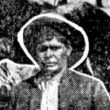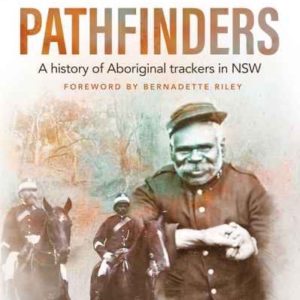Loading map...

Tommy Ryan, a noted Aboriginal stockman on the Upper Clarence between Grafton and Yulgilbar, was born in about 1860. It is likely that he was a Bundjalung speaker. He never worked as a tracker , but his run-ins with police meant that several trackers were sent after him. His story is significant because of his ability to repeatedly escape custody. Ryan first fell afoul of the law in December 1876 when as a 16-year-old youth he was arrested by Grafton Police on suspicion of rape. The evidence was flimsy and the case was dropped the following month. In the 1880s he served a series of short sentences for minor crimes such as stealing and drunk and disorderly behaviour. It was during one of these sentences that he briefly escaped custody for the first time. His cuffed hands were freed by gold digging blacks at Cangai, but Tommy was soon recaptured. In late 1889 he was sentenced to four months for committing grievous assault upon an old Aboriginal man named Napoleon at a pub 15km south of Grafton. Incarcerated in Grafton Gaol, he overpowered a warder in January 1890 and fled to the river, crossing first to Susan Island and then beyond to the western bank. After three weeks on the run he was recaptured late one day near Copmanhurst and transported to the local lock-up as it was too late to take him to Grafton. Upon the lock-up door being reopened the following morning, Tommy rushed at the constable and struggled for his freedom. He grabbed the constable’s revolver and shot him in the mouth before escaping unscathed through the lock-up door. He headed north to Yulgilbar where he took a job on an outstation as a stockman. Others eventually recognised Tommy and called the police in from Drake to arrest him. But he absconded again while being led on horseback to Grafton. The police, severely embarrassed by the multiple escapes and desperate to affect a lasting capture, threatened to withdraw rations from the residents of the Aboriginal camp at Yulgilbar if they did not give up their man. Long Johnny, Billy Cobra[ref]Billy Cobra was the son of Jimmy Cobra, the Gamilaraay man who had guided Edward Ogilvie from the Hunter to Yulgilbar in 1840. Billy’s association with Charlie did not end there – he witnessed Charlie’s burial at Baryulgil (the Aboriginal settlement on Yulgilbar) in October 1929 (DC of Charlie Ryan 1929/015342)[/ref] and Tommy Smith, all Aboriginal stockman on Yulgilbar, subdued Tommy with several others and tied him up. There was no escape this time and Ryan was taken first to Grafton and then to Sydney by steamer before being convicted and serving a lengthy sentence in Darlinghurst Gaol.[ref]Armidale Express and New England General Advertiser 12 January 1877: 4; Darlinghurst Gaol Photographic Description Book, 1890, SANSW Reel 5103 (accessed via Ancestry.com on 4 April 2017); Clarence and Richmond River Examiner 4 March 1890: 2; Illustrated Sydney News 6 March 1890: 27; Richmond River Herald and Northern Districts Advertiser 15 May 1925: 3.[/ref]
At least one tracker had been on his trail, too. Fred Briggs, the Grafton tracker since 1888, had first captured Ryan at Cunglebung in 1889 following the assault of Napoleon. The following year he pursued Ryan after his escape from Copmanhurst. Fred was part of the team that closed in on the fugitive at Yulgilbar and made the arrest. He was a Gumbaynggirr man from Farquarhar’s Creek near Nymboida about 35km south-west of Grafton and it is likely that he had close cultural links with Ryan. The experience of tracking another Aboriginal man from a neighbouring group seems to have convinced Fred that working for the police was not for him as he soon left the job, never to formally return.[ref]Fred first came to the attention of the police after finding his employer, Edward Blaxland, who was lost in a forest on his mountainous Marengo property 60km west of Coffs Harbour. This led to a posting in 1886 at nearby Blick’s River where he helped capture a notorious outlaw known as the ‘Hairy Man’ who had robbed the mail coach running between Grafton and Armidale. Fred captured him in rugged country near Dorrigo. He moved to Nymboida after leaving the job at Grafton, living there for the most part until he passed away in 1935. His only other tracking role came when he was asked to look for two forestry officers lost in mountains west of Nymboida (Guyra Argus 14 March 1935: 4; DC of Fred Briggs 1935/005098) . Tommy Gordon was the Nymboida tracker at the time and seems to have been overlooked for the job. Wafer and Lissarrague regard Bundjalung (also known as Yugambeh-Bundjalung) and Gumbaynggirr as different languages that belong to the same broad linguistic group (2008: 305-351).[/ref]
Although not recorded in official papers, Tommy Gordon of Newbold in Bundjalung country may also have tracked Tommy Ryan. Tommy’s son, Roy Gordon, recalled in 2002 that: “My father was a tracker in them days. The police were after Tommy and they got my father to track him”. It was undoubtedly a dangerous job. Ryan had the reputation as a clever man, a “murragan”, who had used his unearthly powers (including invisibility and teleportation) to evade the police. From his point of view, Tommy Gordon was fortunate not to have captured Ryan. Clever men were known to use their power to bring illness and death to their enemies.[ref]Ryan’s escapades are talked about by Bundjalung people today who still regard him as clever. For information on Bundjalung clever men, see Elkin’s Aboriginal Men of High Degree. According to several of his Bundjalung informants, clever men were made in part by camping and fasting in the bush for at least several weeks near sacred increase sites known as jurraveel (Elkin 1977: 140-141). See Hoff 2006: 253 for Roy Gordon’s account of his involvement of his father in Ryan’s pursuit.[/ref]
Image of Tommy Ryan is courtesy of the Clarence River Historical Society.

 This website explores the history of Aboriginal trackers in NSW from 1862 when the current NSW Police Force was established through to 1973 when the last tracker, Norman Walford, retired. You can read about the lives of individual trackers and some of the incredible tracking feats they...
This website explores the history of Aboriginal trackers in NSW from 1862 when the current NSW Police Force was established through to 1973 when the last tracker, Norman Walford, retired. You can read about the lives of individual trackers and some of the incredible tracking feats they...

There were over 200 NSW police stations that employed Aboriginal trackers between 1862 and 1973. Many were concentrated in the central-west and north-west of the state, the agricultural and pastoral heartland of NSW. This is because one of the main jobs of trackers was to pursue sheep, cattle and horse thieves. Trackers sometimes lived in small huts out the back...
Learn More ►
Pathfinders book Pathfinders, A history of Aboriginal trackers in NSW, written by Dr Michael Bennett and published by NewSouth, is now available from all good bookstores. Click on the link below to order your copy. https://www.abbeys.com.au/book/pathfinders-a-history-of-aboriginal-trackers-in-nsw.do Early History Since the beginning of the colony, government agencies, explorers, surveyors and members of the general public called upon the tracking...
Learn More ►